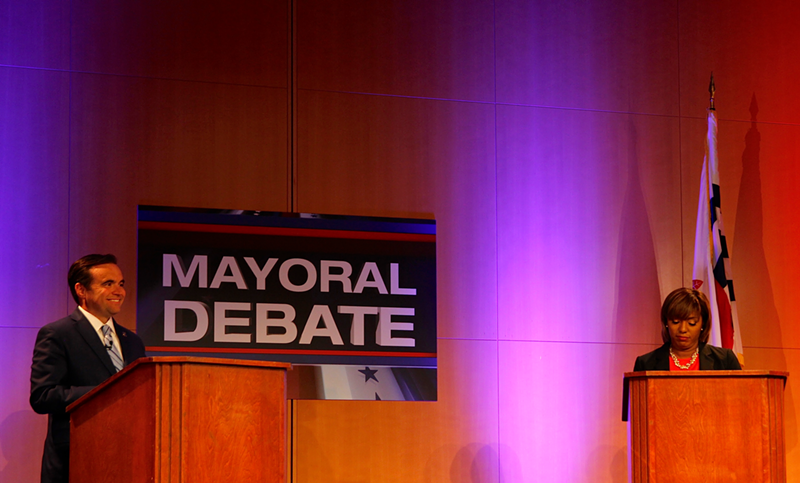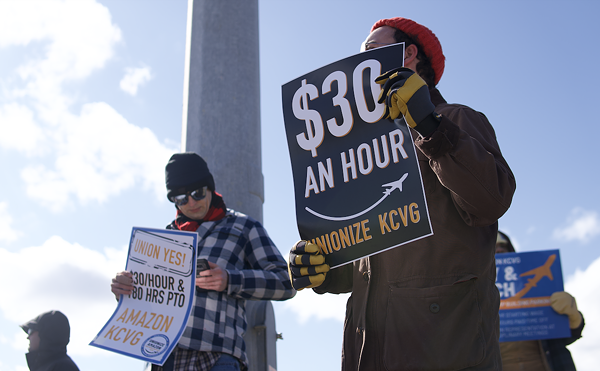Just a month before voters go to the polls, Mayor John Cranley and Councilwoman Yvette Simpson faced off Oct. 10 in a forum that drew out their differences more sharply than ever.
While the candidates pinged between questions about transit, police-community relations and other topics, they cycled, again and again, back to a couple core issues: the best way to deal with the city’s largest companies and institutions as well as the city's own contracting practices as it seeks to increase economic inclusion.
Cranley’s pitch: The city is doing well, and his focus on basic services like police and fire along with his supportive stance toward Cincinnati’s business community are the reasons why. Large institutions like P&G, Children's Hospital and others create jobs, and asking more from them would put that at risk.
“We have a proven track record of progress,” Cranley said. “Objectively, the city is better off today than it was four years ago. There was no GE building on the riverfront. There was no Kroger building a new grocery store downtown with a $90 million building on top. There was no Mercy Hospital headquartered in Bond Hill, and of course Children’s hadn’t agreed to make the largest single investment in the history of the city. There was no FC Cincinnati.”
Simpson, meanwhile, made the case that progress in Cincinnati isn’t reaching everyone, despite the large developments Cranley touts, and that big, visionary changes are needed to extend more opportunities to the city’s residents. That means listening more to neighborhood groups, providing more resources directly to neighborhoods in various stages of development through a plan she calls "Ready, Set, Go" and asking for more from big institutions like Children’s Hospital, developers and large corporations.
“Far too many people are still waiting on their worlds to change, and there’s still so much for us to do,” she said. “I envision a Cincinnati with thriving, diverse neighborhoods that provide ample opportunities for the people who live and work there … where both longterm residents and newcomers are proud to call this city home.”
Simpson says she has a good relationship with Cincinnati’s business community. But recent events — the tumult over the expansion of Children's Hospital is a primary example — have shown she’s willing to push back at times.
Cranley distilled his approach — and his views on the importance of the city’s largest businesses — with an anecdote at last night’s debate.
“We need leadership that’s collaborative and not hostile," he said during a question about luring a new Amazon headquarters to the region. "After I was elected mayor, I made the two calls the following morning. First, I called Procter & Gamble. I said, ‘You’re kind of a big deal. If you ever need me, let me know.’ This is not a game. This is about the future of our region.”
Over the past few weeks, Cranley has hit Simpson hard for her part in a City Council motion asking Children’s Hospital to significantly up its contribution to community efforts in Avondale as it sought a zoning variance from the city tied to a $550 million expansion effort. That motion didn’t pass council, and Children’s rebuked the effort.
That proposal asked Children’s to invest five percent of the value of the tower development — about $27.5 to $32 million — into Avondale over the next decade as it sought its zoning variance. That’s more than the $11.5 million Children’s is investing in the neighborhood to improve housing there, but less than a $100 million investment the Avondale Community Council once asked for, according to an Avondale Community Council powerpoint about the plan.
The proposal also called for a commitment from the hospital to improve health outcomes in the neighborhood by 10 percent over the next decade and for the city to reinvest back into Avondale the $562,000 it would gain from selling the right of way on Erkenbrecher Ave.
The Avondale Community Council and other neighborhood groups opposed Children’s expansion as it is planned because it will necessitate the demolition of 16 houses and relocation of several families. That opposition is informed by a history of expansions of large institutions like Children’s and the Cincinnati Zoo.
Avondale's population of 12,500 is 90 percent black and has seen its median household income of about $20,000 lag well behind Cincinnati's median income of $34,000. Life expectancy there — an area with two major hospitals — is twenty years less than the citywide average. That's mostly due to widespread disinvestment dating back to the 1960s. But even as jobs and economic opportunities have remained scarce for many black residents there, Children’s campus has gotten bigger.
When a moderator at the forum hosted by WCPO at the Cincinnati Art Museum asked if neighborhood residents should have a say in development happening around them, Simpson was emphatic.
“They live there, they pay taxes there, what happens next to them impacts them more than anybody," she said.
Critics, including Cranley, have said that Simpson and fellow council members Wendell Young and Chris Seelbach attempted to “extort” Children’s with their request for more money for neighborhood projects. In past debates, Simpson has had a hard time beating back the accusation that her request of the hospital is a sign she’s hostile to businesses and development.
This time, she had a clearer answer to Cranley’s critiques.
Simpson outlined immense efforts hospitals in other cities like Columbus and Dayton have made to shore up low-income neighborhoods around their facilities. Children’s is aware of other models — it took Avondale Community Council members to tour some of them — and has made investments into Avondale, including primary care for needy children in the low-income, predominantly black neighborhood. But other hospitals do more, and Children's should consider the investment models illustrated in other cities, Simpson said.
“My proposal was a way for them to do what these other cities have done, which is have vibrancy around the hospital,” she said. “I think that’s a win-win for Children’s and for the community around it. I’m not going to apologize for recommending something that could have been a great, visionary thing to do. I will accept the fact that it was rejected. But I think a great mayor puts those proposals on the table and makes sure that the community and business community are there.”
Cranley, however, took sharp offense to that idea.
“They’re part of the solution, not part of the problem,” he said. “The way they talked about Children’s is as if Children’s owed us. They are a symbol of our progress and we should be working with them.”
The two also sparred over efforts to include more minority-owned businesses in the city’s contracting.
Cranley touts the creation of the Office of Economic Inclusion as a positive move toward that goal. But Simpson has questions about the data Cranley cites when he talks about those efforts, and she says the city needs to aim higher anyway and work harder on broader economic inclusion goals.
Cranley pointed out the fact that the city has made huge progress in minority inclusion on city contracts — 17 percent of contracts awarded by the city in 2016 went to such businesses, a big increase from years prior, when the city spent only two or three percent of its contracting money with minority- or women-owned businesses.
The mayor takes credit for the increase after the creation of the Office of Economic Inclusion during his tenure.
“If I put my mind to something we work really hard to accomplish it, and that’s why we’ve seen progress on so many different fronts,” he said.
But Simpson repeated a claim she made in debates last week — that Cranley’s figures aren’t an apples-to-apples comparison. The 17 percent counts contracts awarded, not the actual dollars spent that the three percent figure Cranley cites measures.
While the city awarded roughly $19.6 million in contracts to minority- and women-owned firms last year, it paid out only $8.7 million to those companies. It’s unclear what the city’s total spending on contractors was last year. CityBeat has filed a records request for that information.
Cranley again didn’t have a clear answer to the question — saying only that he didn’t have the report in front of him and that the figure was public information. He said the same thing last week in response to the question from Simpson.
“The spending lags the award,” he explained. “You and I have the same access to the same information. It’s a public document.”
Simpson continued pressing.
“So, for the record, I’m still waiting on that spend percentage,” she said. “It is not 17 percent. It’ll probably be something less than that. It’s important to know. We’ve got to make sure we’re fixing the problems in our current system, and then we’ve got to think bigger.”
The candidates also tangled over other, somewhat more tangential issues. Simpson accused the mayor of once suggesting the city put up a fence around Winton Terrace in an effort to address crime there. Cranley called that a lie.
A Cincinnati Enquirer article seems to suggest Cranley did make the suggestion at an Aug. 2015 community meeting in the low-income neighborhood.
"Cranley acknowledged he didn’t have an answer yet, but he pitched an idea: installing a gated entrance to Winton Hills’ public housing developments, complete with armed guards," the article states, going on to quote Cranley saying the following:
“ 'If you had an armed guard and you lived there or had permission, you’re allowed in,” suggested Cranley, who said the guards would turn away people wanting to enter who weren’t invited. “It’s something worth exploring.' ”






